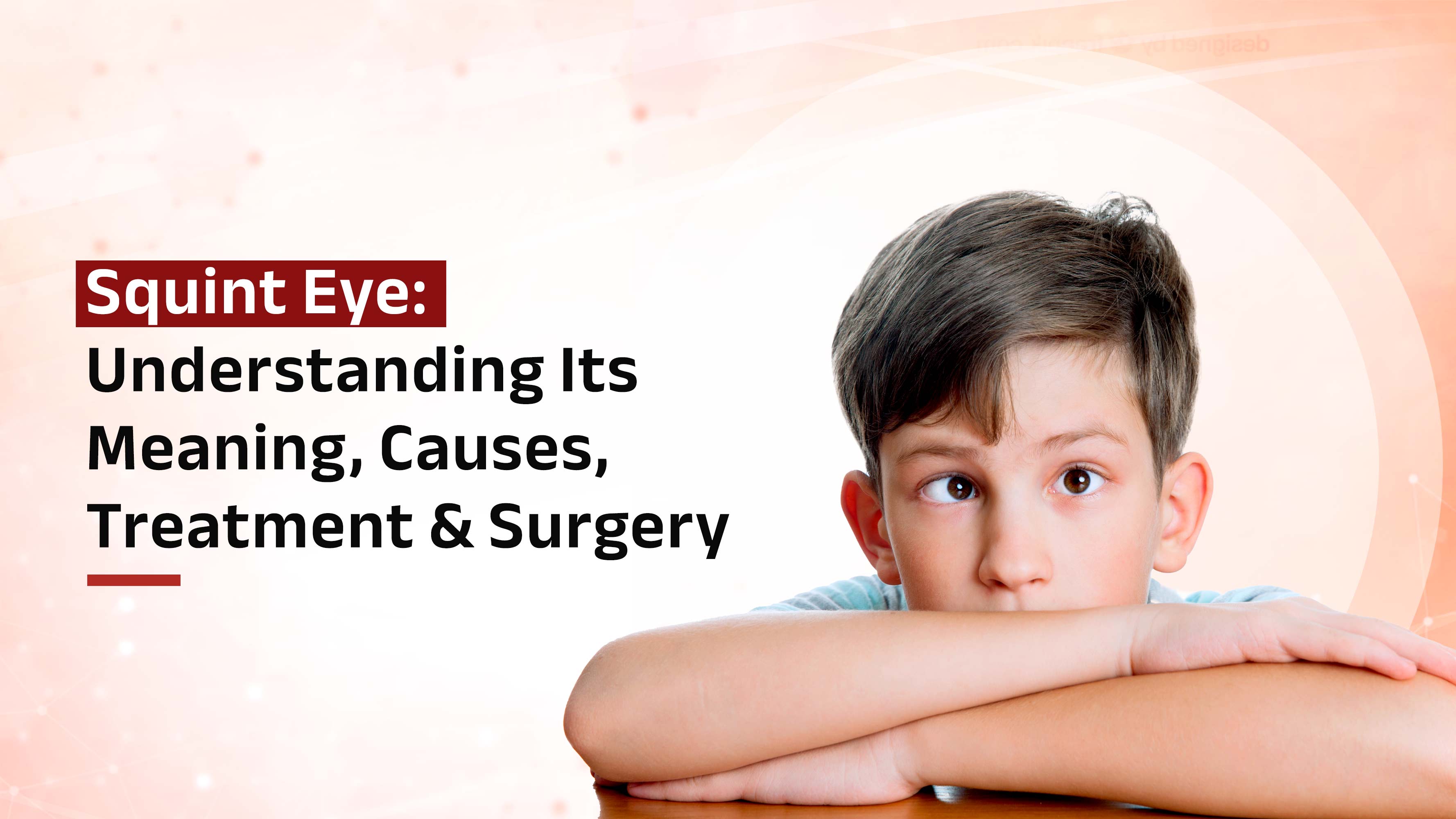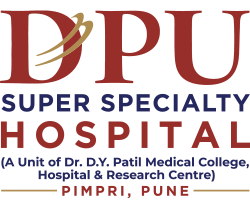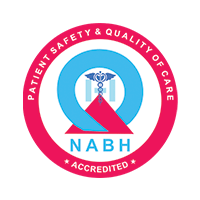Squint Eye Meaning, Causes, Treatment, Surgery

Squint Eye (Strabismus): What is It?
Strabismus, also known as crossed eyes or squint eyes, is a vision disorder that affects a person's ability to align both eyes simultaneously. When someone has strabismus, their eyes do not work together and are misaligned. One eye may look straight ahead while the other eye gets turned inward, outward, upward, or downward. It results in a loss of depth perception and can cause double vision.
Strabismus[1] can occur in one or both eyes and be constant or intermittent. There are different types of strabismus; they depend on the direction in which the eyes are misaligned. For example, esotropia happens when one eye turns inward, while exotropia occurs when one eye turns outward. Hypertropia occurs when one eye turns upward, and hypotropia occurs when one eye turns downward.
While strabismus can develop at any age, it often occurs in infants and young children. If left untreated, strabismus can lead to amblyopia, also known as lazy eye, which can cause permanent vision loss in the affected eye.
Squint Eye (Strabismus): Types
There are different types[2] of strabismus; they depend on the direction in which the eyes are misaligned. Some common types of strabismus include:
- Esotropia: inward turning of one or both eyes
- Exotropia: outward turning of one or both eyes
- Hypertropia: upward turning of one or both eyes Hypotropia: the downward turning of one or both eyes
- Alternating strabismus: alternating between one eye turning in and the other turning out
- Congenital strabismus: present at birth Acquired strabismus: develops later in life, often due to injury, illness, or other underlying conditions
Strabismus can also be classified based on the frequency and duration of the misalignment. Intermittent strabismus occurs when the eyes are misaligned only some of the time, while constant strabismus occurs when the misalignment is present all the time.
Squint Eye (Strabismus): Symptoms
The symptoms[1] of strabismus can vary depending on the type and severity of the misalignment. Some common symptoms include:
- Misaligned eyes
- Double vision
- Poor depth perception
- Eye strain or discomfort
- Headaches
- Squinting or closing one eye
- Tilting the head to one side
- Difficulty with tasks that require visual concentration, such as reading or driving
Symptoms may present continuously or only occur during certain activities or times of the day. If you experience any of these symptoms, see an eye doctor for a comprehensive eye exam immediately.
Squint Eye (Strabismus): Causes
Determining the underlying cause[2] of strabismus can help treat and manage the condition properly. Here is a more detailed list of the different causes of strabismus:
- Problems with the muscles that control eye movement: Strabismus can occur when the muscles that control eye movement are not working well. It can be due to issues with the muscles or the nerves that control them.
- Nerve abnormalities that affect eye movement: Strabismus can also occur due to abnormalities in the nerves that control eye movement. It can be due to conditions such as multiple sclerosis or brain tumors.
- Refractive errors: Refractive errors such as nearsightedness, farsightedness, or astigmatism can cause the eyes to become misaligned.
- Genetics or family history: Strabismus can run in families, and a genetic component to the condition can be present.
- Brain injuries or neurological conditions: Traumatic brain injuries, strokes, and other neurological problems can affect the muscles or nerves that control eye movement and lead to strabismus.
- Medical conditions: Certain conditions, such as diabetes, thyroid disease, or myasthenia gravis, can cause strabismus.
- Medications: Some medications can affect the muscles or nerves that control eye movement, leading to strabismus.
- Prolonged or untreated amblyopia: Amblyopia, also known as "lazy eye," is a condition where one eye has reduced visual acuity. If left untreated, amblyopia can lead to strabismus as the brain tries to compensate for the weaker eye.
Squint Eye (Strabismus): Diagnosis & Test
Here are some diagnostic tests[3] that your doctor may perform for squint eyes or strabismus:
- Comprehensive eye exam: An eye doctor will perform a complete eye exam to check for any eye abnormalities or vision.
- Cover/uncover test: This involves covering one eye at a time while the person looks at a target. The doctor will observe the uncovered eye to see if it moves to take over fixation from the covered eye.
- Alternate cover test: This test is similar to the cover/uncover test but involves quickly switching the cover between the eyes to see how they move with each other.
- Prisms and lenses test: This test involves using prisms and lenses to determine the amount and direction of any eye misalignment.
- Visual acuity test: This test measures how well a person can see letters or objects at a distance.
- Refraction test: This test measures the amount of refractive error, such as nearsightedness, farsightedness, or astigmatism, that a person has.
- Eye movement test: This test evaluates the range and quality of eye movements and can help identify any muscle weakness or nerve problems.
- Medical history and physical examination: The doctor may ask about the person's medical history and perform a physical exam to check for any underlying conditions causing the strabismus.
Based on the results of these tests, the doctor can diagnose the type and severity of strabismus and develop a treatment plan.
Squint Eye (Strabismus): Treatment & Surgery
The treatment[1] of strabismus, also known as squint eyes, can vary depending on the type and severity of the condition. Treatments can include eyeglasses or contact lenses, eye exercises, prism lenses, Botox injections, vision therapy, and surgery. It's crucial to consult with an experienced eye doctor to determine the most appropriate treatment plan. Here are some treatment options[2] for squint eyes or strabismus:
- Eyeglasses or contact lenses: In some cases, wearing corrective lenses can help straighten the eyes and improve vision.
- Eye exercises: Special eye exercises can strengthen the eye muscles and improve eye coordination, which can help reduce the severity of strabismus.
- Prism lenses: These lenses can help correct double vision caused by strabismus.
- Botox injections: Injecting botulinum toxin into the affected eye muscles can help weaken them, reducing the degree of misalignment.
- Vision therapy: This type of therapy involves a combination of eye exercises, prism lenses, and other techniques to improve eye coordination and correct strabismus.
- Surgery: In more severe cases, surgery may be necessary to correct the alignment of the eyes. During the procedure, the eye muscles get repositioned to improve eye alignment and reduce double vision.
The treatment approach will depend on the type and severity of strabismus, as well as the age and overall health of the patient. Different treatment combinations may be necessary to achieve the best results for some people.
Squint Eye (Strabismus): Surgery Cost
The cost of strabismus surgery in India can vary depending on several factors, including the type and severity of the condition, the surgeon's expertise, the hospital or clinic where the procedure gets performed, and the location within India. However, to give an idea of the average cost, here are some rough estimates:
- The cost of strabismus surgery can range from around INR 25,000 to INR 1,50,000, depending on the factors mentioned here.
- The cost may be higher for complex cases that require more extensive surgery.
- The cost may also vary depending on the type of procedure, as different surgical techniques can get used to treat strabismus.
It's important to note that these estimates are just a general guideline, and actual costs may vary depending on individual circumstances. Patients should consult with a qualified eye doctor to get a fair idea of the expected costs for their specific case.
Squint Eye (Strabismus): Surgery Age Limit
There is no specific age limit for strabismus surgery. The decision to perform surgery depends on the individual case and the severity[3] of the condition. In some cases, surgery may be recommended at a young age to prevent vision problems and to help develop normal visual pathways in the brain. In other cases, surgery may get recommended later in life if the individual is experiencing double vision or has cosmetic concerns.
However, it's important to note that strabismus surgery is generally not recommended for infants under six months, as their visual system is still developing, and the condition may resolve eventually. Ultimately, you should consult an experienced eye doctor before getting strabismus surgery and the surgery timing.
Squint Eye (Strabismus): Surgery Recovery Time
The recovery time[2] for strabismus surgery can vary depending on the individual case and the extent of the surgery. Generally, the recovery period lasts for several weeks. During this time, it is common for the eyes to be red and swollen and for the individual to experience some discomfort or mild pain. Eye drops or ointments may get prescribed to help reduce inflammation.
The following are some general guidelines for the recovery period after strabismus surgery:
- The individual may need to wear an eye patch or shield for some time after the surgery.
- Avoid strenuous activity, including heavy lifting, for at least a week after surgery.
- It is important to avoid rubbing or touching the eyes during recovery.
- Follow-up appointments with the eye doctor will be necessary to monitor the healing process and ensure it was a successful surgery.
Overall, the recovery time for strabismus surgery is relatively short, and most individuals can resume their normal activities within a few weeks.
Squint Eye (Strabismus): Surgery Side Effects
While strabismus surgery is generally considered safe[3], there are potential side effects that individuals should be aware of. These can include:
- Double vision or blurry vision: Some individuals may experience double vision or blurriness after the surgery, which can last a few days to a few weeks. It is usually temporary and should resolve on its own.
- Infection: As with any surgery, there is a risk of infection. Signs of infection include redness, swelling, and discharge from the eye. If these symptoms occur, seek medical attention right away.
- Bleeding: There may be some bleeding in the eye after the surgery, which can cause temporary vision problems.
- Recurrence of strabismus: In some cases, the strabismus may recur after the surgery, requiring further treatment.
- Under- or over-correction: The surgery may result in under- or over-correction of the eye alignment, which can cause persistent or recurring double vision or strabismus.
- Loss of vision: In rare cases, strabismus surgery can result in a loss of vision in the affected eye.
It is vital to discuss any potential risks or complications with an eye doctor before undergoing strabismus surgery.
Squint Eye (Strabismus): Surgery Success Rate
The success rate of strabismus surgery can vary depending on the individual case, the severity of the strabismus, and the specific surgical technique used. However, in general, strabismus surgery has a high success rate.
It is important to note that while strabismus surgery can improve the alignment of the eyes, it may not necessarily improve vision or correct any underlying vision problems. An eye doctor can provide more information on the expected outcomes of strabismus surgery in individual cases.
Squint Eye (Strabismus): Problems That Can Occur If A Squint Is Not Treated
If left untreated, a squint (strabismus) can cause several problems[4], including:
- Amblyopia (lazy eye): If the brain begins to favor one eye over the other due to the misalignment of the eyes, the other eye may become underused and not develop properly, leading to vision problems.
- Double vision: When the eyes are misaligned, the brain may receive two different images, leading to double vision and difficulty seeing clearly.
- Depth perception issues: One's ability to perceive depth often gets affected by a squint, making tasks such as driving or playing sports more challenging.
- Social and emotional issues: Children with a squint may experience teasing or bullying, affecting their self-esteem and emotional well-being.
It is vital to seek treatment for a squint as early as possible to prevent these complications from occurring.
Squint Eye (Strabismus): Exercise
Exercises for squint eyes get designed to improve the alignment and coordination of the eyes. Here is a list of some that an eye specialist may recommend:
- Pencil push-ups:- Hold a pencil at arm's length and slowly bring it closer to your nose. Focus on the pencil until you see double, then try to merge the two images into one image. Repeat this exercise several times a day.
- Eye tracking exercises:- Place two objects at different distances and move your eyes between them without moving your head. It can help improve eye movement and coordination.
- Brock string exercises:- These exercises involve using a string with several beads tied to it. These beads are arranged at different distances, and the patient gets instructed to focus on each bead. It can help improve depth perception and eye coordination.
- Computer programs:- There are several computer programs available that can help improve eye tracking and coordination. You can perform these under the guidance of an eye specialist.
- Vision therapy:- This is a customized program of exercises and activities designed to improve specific vision problems, including squint.
It is important to note that exercises alone may not be sufficient to correct a squint and surgery or other treatments may be necessary in some cases. Always consult an eye specialist before beginning any exercises or treatment for a squint.
Squint Eye (Strabismus): When To Get Medical Advice?
It is recommended to seek medical advice[4] for squint eyes as soon as possible, especially if it is a sudden onset or if there is a noticeable change in the alignment of the eyes. Some situations that warrant immediate medical attention include:
- Double vision
- Pain or discomfort in the eye
- Headaches or eye strain
- Difficulty reading or performing other visual tasks
- Eye turning in or out
- A droopy eyelid
- Reduced vision or loss of vision
It is always better to seek medical attention early, as early diagnosis and treatment can prevent further complications
Squint Eye (Strabismus): FAQs
Vision problems can cause unnecessary stress and strain on your eyes and mind. Therefore, getting appropriate answers to your questions remains paramount. Here are answers to the most commonly asked questions concerning squint eyes or strabismus.
Q1. Can squint eyes be corrected?
Yes, using surgical and non-surgical techniques, squint eye is treatable in adults, depending on the cause and severity of the condition. The fundamental approach is still the best way to ensure eye alignment. However, compared to children, adults may experience different functional visual outcomes.
Q2. Is squint eye curable?
Squint eye is curable if you seek treatment at the right time. Speak with an eye specialist to gain a further understanding of your eye condition and get treatment options accordingly.
Q3. Can squint eye be corrected in adults?
By assisting your eyes in focusing, glasses or contact lenses can occasionally be used to control strabismus. The presence of double vision can frequently be reduced by donning glasses with unique prism lenses. An affected eye can be temporarily straightened with Botox injections into the eye muscle.
Q4. Is squint eye hereditary?
Yes, children who have a history of frequent squinting are more likely to experience the same disorder.
Q5. Can squinting cause eye bags?
Eye strain can result from reading, squinting, or trying to see distant objects. Blood vessels expand when your eyes are strained, enhancing the appearance of puffiness and dark circles.
Q6. Is squint eye surgery painful?
The eye will probably be painful for a few days, at the very least. You might be given eyedrops to aid healing and painkillers to lessen discomfort.
Q7. Is there any treatment for squint eyes?
There are several treatment options available for squint eyes. Depending on the severity of your condition, your eye doctor will recommend the appropriate treatment for you.
Conclusion
In conclusion, squint eye or strabismus is a condition that affects the alignment of the eyes and can cause a range of symptoms and complications if left untreated. While the causes of strabismus can be varied, early diagnosis and treatment are crucial for the best possible outcome. Treatment options can include vision therapy, the use of corrective lenses or prisms, and surgery. A healthy lifestyle and regular eye exams can also help to prevent or manage squint eye or strabismus.
Experience Advanced Eye Treatment at DPU Hospital
Consult your eye doctor if you suspect you have a squint eye. If you are unsure which doctor to contact, contact our experts at DPU Hospital. If the doctor believes your eye condition is serious, they may refer you for surgery. Our certified and experienced eye surgeons specialize in advanced surgery and can conduct a surgical evaluation. Don't put off your surgical evaluation; request an appointment with the doctor today.








